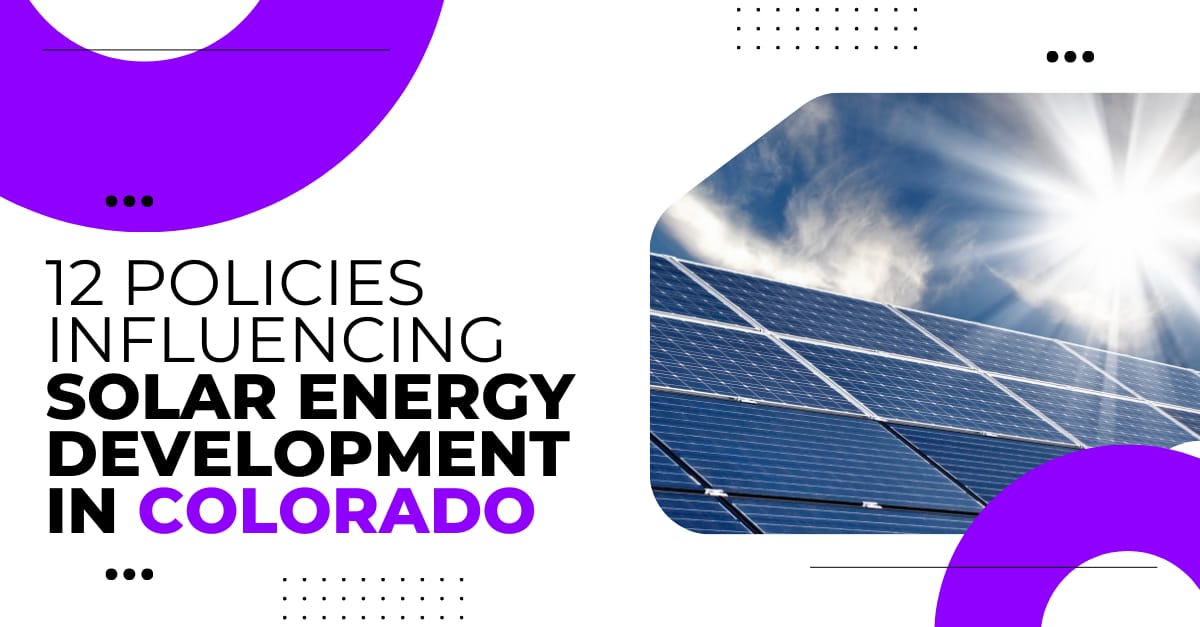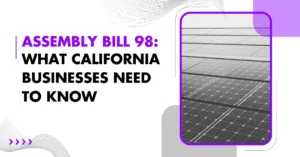12 State and Federal Policies Influencing Solar Energy Development in Colorado
Axel Presali
on
March 3, 2025

 2025-03-03
2025-03-0312 State and Federal Policies Influencing Solar Energy Development in Colorado
Colorado is leading the way in renewable energy policy, ranking fourth in the nation (number one with coastal states exempted!) in climate action.
The Centennial State has big, bright goals in place, including achieving 100% net zero greenhouse gas emissions by 2050 It is rapidly becoming a trailblazer in clean energy transitions.
For the solar industry in particular, there are several state and federal policies to pay attention to. These landmark regulations have not only put significant monetary incentives on the table for businesses interested in switching to clean power, but for homeowners as well.
State and Federal Policies to Watch in the Colorado Renewable Energy Market
Let’s dig deeper into the policies that are driving these advancements, and pushing Colorado’s solar energy scene forward.
1. Federal Investment Tax Credit
Also referred to as the ITC, the Federal Investment Tax Credit has had a massive influence on Colorado’s solar industry, just as it has around the rest of the country.
Established to incentivize the adoption of renewable energy, the ITC provides residential and commercial property owners with a tax credit equal to 30% of the cost of installing a solar energy system.
Colorado has seen a sharp increase in the adoption of solar thanks to this federal policy, as it reduces the upfront costs of solar panels and makes installation more accessible for middle-income households and small businesses.
Aside from this direct benefit, the ITC has also indirectly benefited the solar industry in Colorado by creating new jobs in installation, manufacturing, and supply chains. Better yet, the ITC also includes additional adder credits for programs that serve low-income communities, or for those that meet specific labor and apprenticeship standards.
2. Federal Inflation Reduction Act
Perhaps the most famous of all federal initiatives passed to forward the renewable energy industry, the Inflation Reduction Act (IRA) was signed into law in 2022. It provides billions of dollars in incentives for renewable energy development and is widely regarded as the most ambitious climate effort in U.S. history.
Thanks to the IRA, businesses and municipalities in Colorado can access grants, loans, and additional tax credits to kick-start or expand their renewable energy projects. Small-scale solar farms and rooftop solar systems are receiving financial boosts that previously might have been out of reach.
Most importantly, the IRA complements existing state-level initiatives, allowing Colorado to supercharge its solar adoption while targeting its 80% renewable electricity goal by 2030. Companies looking to invest in solar infrastructure can now benefit from a dual incentive structure, with a combination of federal support and state-level backing.
3. Renewable Energy Standard
Colorado set the bar extraordinarily high when it established its Renewable Energy Standard (RES) back in 2004. Under these policies, investor-owned utilities must achieve 30% renewable energy by 2020, with updated goals for 100% clean energy by 2050.
By requiring utilities to source a portion of their energy from renewables, this policy has led to a competitive surge in solar projects across the state, from large-scale utility solar farms to distributed rooftop systems.
In addition, these distributed generation requirements make sure local communities benefit directly from solar energy through projects like community solar gardens. All in all, the RES has created a booming marketplace for solar companies and also streamlined the permitting process for both residential and commercial installations.
4. HB19-1261: Climate Action Plan to Reduce Pollution
HB19-1261, also known as the Climate Action Plan to Reduce Pollution, is another jewel in Colorado’s renewable energy crown. Signed into law in 2019, the act mandates cutting greenhouse gas emissions by 26% by 2025, 50% by 2030, and 90% by 2050, all based on 2005 levels.
Focusing on three key pillars, this legislation equally targets a transition to clean energy sources while also mitigating pollution, and for the solar industry, it has served as a call to action.
It has led to increased funding and support for solar projects due to its key role in cutting emissions. It also provides provisions for equitable transitions to make sure the policies benefit all Coloradans regardless of income, gender, age, race, or any other demographic trait.
5. Colorado Greenhouse Gas Pollution Reduction Roadmap
Released in 2021 and updated with Roadmap 2.0 in 2023, the Colorado Greenhouse Gas Pollution Reduction Roadmap outlines a practical pathway to achieve the state’s climate targets.
With near-term actions driving emissions reductions across all sectors, the roadmap has positioned Colorado to be more than 80% of the way toward its statutory 2030 climate goal.
This roadmap identifies clear areas where solar can and will have the most impact, such as reducing emissions in the power sector. Solar companies around the state have used this guidance to align their efforts with state priorities.
It also emphasizes the advancement of community silicone through things like solar microgrids and storage solutions, all of which can align the broader clean energy transition with local needs.
6. MOU with Wyoming Regarding Direct Air Capture
The recent Memorandum of Understanding (MOU) with Wyoming is yet another policy that positions Colorado as a leader in Direct Air Capture (DAC) technology.
Through teaming up with its neighbor, Colorado is developing innovative solutions for carbon dioxide removal while exploring federal grant opportunities to advance these technologies. This bipartisan initiative has the potential to significantly impact the renewable energy landscape in the Mountain West and has already had significant ramifications right here in Colorado.
7. Colorado Environmental Justice Act
Passed in 2021, this act demands a 20% reduction in greenhouse gas emissions from industrial and manufacturing sectors by 2030.
With the goal of holding businesses accountable, the policy not only mitigates environmental harm but also motivates the integration of renewable energy and clean technology into industrial operations across the state.
8. Clean Heat Plans
In 2021, Colorado became the first state in the nation to require gas utilities to reduce greenhouse gas emissions through Clean Heat Plans under SB21-264.
By setting clear targets—4% reduction by 2025 and 22% by 2030 (relative to 2015 levels)—the state is pushing utilities to adopt cleaner solutions like renewable natural gas and hydrogen.
This bold initiative leads the way in tackling emissions in traditionally overlooked areas, encouraging utilities to innovate in gas distribution while providing transparency to consumers.
9. Colorado Clean Energy Fund
For homeowners looking to make the switch to renewables, the Residential Energy Upgrade (RENU) Loan Program, sponsored by the Colorado Clean Energy Fund, offers an accessible financing option.
With no money down, below-market interest rates, and terms up to 20 years, residents can upgrade their homes with solar panels, energy-efficient heating, or even EV charging stations.
This program reduces the financial hurdles for individuals, bringing renewable technology into reach for those who may otherwise find it too costly.
10. Colorado Commercial Property Assessed Clean Energy
Commercial property owners aren’t left behind, either, thanks to C-PACE. This financing tool allows businesses to fund renewable and energy-efficient upgrades with up to 100% coverage of costs.
Repayments are made through a special property tax assessment, making it an attractive option for long-term investments in energy efficiency.
To date, Colorado’s C-PACE program has financed over $250 million in private-sector clean energy investments, spanning commercial, industrial, and multi-family property sectors.
11. Federal Public Utility Regulatory Policies Act (PURPA) of 1978
Introduced in 1978, the Public Utility Regulatory Policies Act (PURPA) set the stage for decentralized renewable energy production.
Though it’s one of the oldest regulations still in place that govern the clean energy landscape in Colorado, it’s a landmark one. Essentially, it requires utilities to purchase energy from smaller renewable energy producers at fair rates.
Since its inception nearly fifty years ago, PURPA has opened the door for countless independent solar and wind projects in Colorado. This approach encourages competition, curbs energy monopoly practices, and promotes affordable energy prices for consumers.
12. Renewable Portfolio Standards
Another key driver is Renewable Portfolio Standards (RPS). These standards require electric utilities to source a specific percentage of their power from renewable energy.
For Colorado, RPS implementation has spurred significant investments in solar, wind, and other renewables, aligning the state’s energy policies with broader federal goals.
The Takeaway
Colorado’s renewable energy market is prime for innovation and growth, but navigating the varying policies, incentives, and technologies can be challenging.
IE Construction specializes in solar solutions for businesses and homeowners, helping you unlock the benefits of these policies with minimal hassle.
From advising on financing options like RENU and C-PACE to seamlessly installing advanced solar systems, our team guarantees that your transition to renewable energy is as smooth as possible.
Contact IE Construction today to learn how we can help you build a brighter, greener future. Let’s work together to shape the energy market of tomorrow!
- Category: Blog



